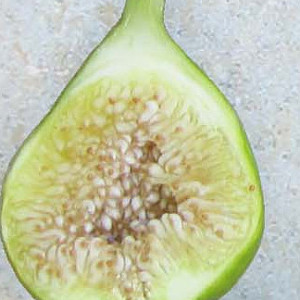This site contains affiliate links for which I may be compensated.
Genoa
Genoa Information


-
Possible Synonyms / AKA:
DFIC 30
-
Introduced By:
-
Origin:
-
Main Flavor Group:
-
Family Group:
-
Fig Type:
Common - Self fertile and will grow anywhere conditions are suitable -
Cold Hardy:
N/A -
Container Variety:
N/A -
Easy Rooting:
N/A -
Main Season:
any -
Availability:
N/A -
Breba Crop:
N/A -
Seed Crunch:
N/A -
Eye:
N/A -
Skin Toughness:
N/A -
Fruit Size:
N/A -
Rain Resistance:
N/A -
Tree Vigor:
N/A -
External Links:
https://docs.google.com/spreadsheets...t?usp=drivesdk
https://npgsweb.ars-grin.gov/gringlobal/accessiondetail.aspx?id=1001072
https://figuesdumonde.wordpress.com/2017/01/14/genoa/
Description
DFIC 30 "Genoa" and DFIC 81 "Genoa White" are considered synonyms in Dr. Aradhya's 2010 study:
https://docs.google.com/spreadsheets...t?usp=drivesdk
https://docs.google.com/spreadsheets...t?usp=drivesdk
Condit Monograph
Genoa: (syns. Genoa White, White Genoa). Described by Miller (1768), Forsyth (1803), Lindley (1831), Rogers (1834), Holley (1854), M'Intosh (1855), Dochnahl (1855), White (1868), Hogg (1866), G. S. (1869), Massey (1893), Eisen (1885, 1897, 1901), Davis (1928), Burger and DE Wet (1931), and Condit (1947). Illustrated by Eisen, who stated that the identity of this variety and the origin of its name had not been established. It is not identical with Marseilles White, as given by Rogers and by some other authors. Although long grown in England, the Genoa has not been favored so highly as certain other varieties, partly because the trees are such light producers. Davis reports that this variety is grown in all parts of the Union of South Africa, where it ''rejoices in eleven other names, amongst them White Marseilles.'' He regards the fruit as good both for eating fresh and for drying.
In 1853, W. B. West, of Stockton, California, imported several varieties, including White Genoa, from Hovey & Co., Boston; and in 1883, the California Nursery Company, Niles, obtained it from England. The variety was tested at the California Experiment Stations, but did not prove to be outstanding, either in tree production or in fruit quality. Genoa has not been planted commercially in California, and is not recommended for dooryard planting in the interior valleys. However, in coastal districts, some growers report excellent results with it. At San Simeon, for example, the tree produces two crops in favorable seasons; the first matures after the middle of August, and following a short intermission, the second crop continues until frost. At San Jose the tree bears well, but fruit is of poor quality, and is inclined to spoil on account of the large eye and hollow center. Both P.I. No. 101,712, introduced in 1933 as Arabaly, and P.I. No. 101,719, introduced as Neapolitan, from Sochi, North Caucasus, proved to be identical with Genoa at Riverside.
Trees are of moderate vigor, with spreading branches; terminal buds tawny to light brown, an unusual character for a green-fruited variety. Leaves medium to large, 3- to 5-lobed; upper surface dull; upper sinuses of medium depth and width, lower sinuses shallow and broad; base broadly subcordate, sometimes Auricled ; margins shallowly crenate. Description is from fruits produced at Riverside and Menlo Park.
Breba crop small; fruits large, 2-1/4 inches in diameter by 2-1/2 inches in length, or in coastal districts more elongated, up to 3-1/2 inches; average weight 80 grams; shape oblique-pyriform, with short neck, or sometimes with longer, curved neck; stalk very short; ribs rather prominent, elevated; eye medium, open, scales chaffy or light rose; white flecks more or less concealed by yellowish-green skin color; skin smooth; bloom inconspicuous; pulp light strawberry, hollow at center; flavor sweet, but not rich; seeds few, small; quality fair. (Plate 22, A.)
Second-crop figs medium or above, up to 2 inches in diameter and 2-1/4 inches in length, somewhat oblique, turbinate; average weight 60 grams; apex broad and flattened; neck very short, or absent; stalk short and thick, or sometimes curved, and up to 3/8 inch long; ribs elevated, mostly prominent; surface dull; bloom hardly perceptible; color greenish yellow, blemished by circular, brown spots at maturity; skin thin, tender, peeling readily; pulp amber, tinged with strawberry, hollow at center; texture gelatinous; flavor mild; quality poor; seeds practically none. Very susceptible to spoilage. (Plate 22, B.)
Caprified specimens with green skin color, dark-strawberry pulp, and large, fertile seeds; inclined to split at maturity. Quality fair as fresh fruit, but poor when dried.
Genoa: (syns. Genoa White, White Genoa). Described by Miller (1768), Forsyth (1803), Lindley (1831), Rogers (1834), Holley (1854), M'Intosh (1855), Dochnahl (1855), White (1868), Hogg (1866), G. S. (1869), Massey (1893), Eisen (1885, 1897, 1901), Davis (1928), Burger and DE Wet (1931), and Condit (1947). Illustrated by Eisen, who stated that the identity of this variety and the origin of its name had not been established. It is not identical with Marseilles White, as given by Rogers and by some other authors. Although long grown in England, the Genoa has not been favored so highly as certain other varieties, partly because the trees are such light producers. Davis reports that this variety is grown in all parts of the Union of South Africa, where it ''rejoices in eleven other names, amongst them White Marseilles.'' He regards the fruit as good both for eating fresh and for drying.
In 1853, W. B. West, of Stockton, California, imported several varieties, including White Genoa, from Hovey & Co., Boston; and in 1883, the California Nursery Company, Niles, obtained it from England. The variety was tested at the California Experiment Stations, but did not prove to be outstanding, either in tree production or in fruit quality. Genoa has not been planted commercially in California, and is not recommended for dooryard planting in the interior valleys. However, in coastal districts, some growers report excellent results with it. At San Simeon, for example, the tree produces two crops in favorable seasons; the first matures after the middle of August, and following a short intermission, the second crop continues until frost. At San Jose the tree bears well, but fruit is of poor quality, and is inclined to spoil on account of the large eye and hollow center. Both P.I. No. 101,712, introduced in 1933 as Arabaly, and P.I. No. 101,719, introduced as Neapolitan, from Sochi, North Caucasus, proved to be identical with Genoa at Riverside.
Trees are of moderate vigor, with spreading branches; terminal buds tawny to light brown, an unusual character for a green-fruited variety. Leaves medium to large, 3- to 5-lobed; upper surface dull; upper sinuses of medium depth and width, lower sinuses shallow and broad; base broadly subcordate, sometimes Auricled ; margins shallowly crenate. Description is from fruits produced at Riverside and Menlo Park.
Breba crop small; fruits large, 2-1/4 inches in diameter by 2-1/2 inches in length, or in coastal districts more elongated, up to 3-1/2 inches; average weight 80 grams; shape oblique-pyriform, with short neck, or sometimes with longer, curved neck; stalk very short; ribs rather prominent, elevated; eye medium, open, scales chaffy or light rose; white flecks more or less concealed by yellowish-green skin color; skin smooth; bloom inconspicuous; pulp light strawberry, hollow at center; flavor sweet, but not rich; seeds few, small; quality fair. (Plate 22, A.)
Second-crop figs medium or above, up to 2 inches in diameter and 2-1/4 inches in length, somewhat oblique, turbinate; average weight 60 grams; apex broad and flattened; neck very short, or absent; stalk short and thick, or sometimes curved, and up to 3/8 inch long; ribs elevated, mostly prominent; surface dull; bloom hardly perceptible; color greenish yellow, blemished by circular, brown spots at maturity; skin thin, tender, peeling readily; pulp amber, tinged with strawberry, hollow at center; texture gelatinous; flavor mild; quality poor; seeds practically none. Very susceptible to spoilage. (Plate 22, B.)
Caprified specimens with green skin color, dark-strawberry pulp, and large, fertile seeds; inclined to split at maturity. Quality fair as fresh fruit, but poor when dried.
If you'd like your banner to be shown here and throughout Fig Database, send us a message.
Photos Add Your Image
No Images Found
YouTube Videos
No Videos Found









